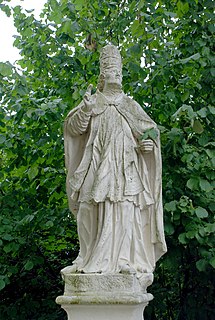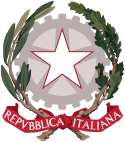
Fibonacci, also known as Leonardo Bonacci, Leonardo of Pisa, or Leonardo Bigollo Pisano, was an Italian mathematician from the Republic of Pisa, considered to be "the most talented Western mathematician of the Middle Ages".
Pope Linus was the bishop of Rome from c. AD 67 to his death. As with all the early popes, he was later canonized.
Pope Pius I was the bishop of Rome from c. 140 to his death c. 154, according to the Annuario Pontificio. His dates are listed as 142 or 146 to 157 or 161, respectively. He is considered to have opposed both the Valentinians and Gnostics during his papacy. He is considered a saint by the Catholic Church and the Eastern Orthodox Church with a feast day in 11 July, but it is unclear if he died as a martyr.
Pope Silverius ruled the Holy See from 8 June 536 to his deposition in 537, a few months before his death. His rapid rise to prominence from a deacon to the papacy coincided with the efforts of Ostrogothic king Theodahad, who intended to install a pro-Gothic candidate just before the Gothic War. Later deposed by Byzantine general Belisarius, he was tried and sent to exile on the desolated island of Palmarola, where he starved to death in 537.
Pope Zosimus was the bishop of Rome from 18 March 417 to his death on 26 December 418. He was born in Mesoraca, Calabria. Zosimus took a decided part in the protracted dispute in Gaul as to the jurisdiction of the See of Arles over that of Vienne, giving energetic decisions in favour of the former, but without settling the controversy. His fractious temper coloured all the controversies in which he took part, in Gaul, Africa and Italy, including Rome, where at his death the clergy were very much divided.
Pope Felix I was the 26th bishop of Rome from 5 January 269 to his death on 30 December 274.

Proserpina or Proserpine is an ancient Roman goddess whose cult, myths and mysteries were combined from those of Libera, an early Roman goddess of wine. In Greek she is known as Persephone and her mother is Demeter, goddesses of grain and agriculture. The originally Roman goddess Libera was daughter of the agricultural goddess Ceres and wife to Liber, god of wine and freedom. In 204 BCE, a new "Greek-style" cult to Ceres and Proserpina as "Mother and Maiden" was imported from southern Italy, along with Greek priestesses to serve it, and was installed in Libera and Ceres' temple on Rome's Aventine Hill. The new cult and its priesthood were actively promoted by Rome's religious authorities as morally desirable for respectable Roman women, and may have partly subsumed the temple's older, native cult to Ceres, Liber and Libera; but the new rites seem to have functioned alongside the old, rather than replaced them.
Pope Telesphorus was the bishop of Rome from c. 126 to his death c. 137, during the reigns of Roman Emperors Hadrian and Antoninus Pius. He was of Greek ancestry and born in Terranova da Sibari, Calabria, Italy.

Pope Gelasius I was the bishop of Rome from 1 March 492 to his death on 19 November 496. Gelasius was a prolific author whose style placed him on the cusp between Late Antiquity and the Early Middle Ages. Some scholars have argued that his predecessor Felix III may have employed him to draft papal documents, although this is not certain. During his pontificate he called for strict Catholic orthodoxy, more assertively demanded obedience to papal authority, and, consequently, increased the tension between the Western and Eastern Churches. Surprisingly, he also had cordial relations with the Ostrogoths, who were non-Nicene ('Arian') heretics, from the perceptive of the Roman church.
Pope Simplicius was the bishop of Rome from 468 to his death. He combated the Eutychian heresy, ended the practice of consecrating bishops only in December, and sought to offset the effects of Germanic invasions.
Pope John I was the bishop of Rome from 13 August 523 to his death. He was a native of Siena, in Italy. He was sent on a diplomatic mission to Constantinople by the Ostrogoth King Theoderic to negotiate better treatment for Arians. Although John was relatively successful, upon his return to Ravenna, Theoderic had him imprisoned for allegedly conspiring with Constantinople. The frail pope died of neglect and ill-treatment.

In ancient Roman religion and mythology, Liber, also known as Liber Pater, was a god of viticulture and wine, male fertility and freedom. He was a patron deity of Rome's plebeians and was part of their Aventine Triad. His festival of Liberalia became associated with free speech and the rights attached to coming of age. His cult and functions were increasingly associated with Romanised forms of the Greek Dionysus/Bacchus, whose mythology he came to share.
In music, biology, and drama, the phrase ad libitum often shortened to "ad lib" or "ad-lib" has various meanings. The roughly synonymous phrase a bene placito is less common but, in its Italian form a piacere, entered the musical lingua franca.

Lasagne are a type of pasta, possibly one of the oldest types, made of very wide, flat sheets. Either term can also refer to an Italian dish made of stacked layers of lasagne alternating with fillings such as ragù, vegetables, cheeses, and seasonings and spices, like Italian seasoning, such as garlic, oregano and basil. The dish may be topped with grated cheese, which becomes melted after baking. Typically cooked pasta is assembled with the other ingredients and then baked in an oven. The resulting baked pasta is cut into single-serving square portions.

The Sanctuary of Saint Michael the Archangel is a Roman Catholic shrine on Mount Gargano, Italy, part of the commune of Monte Sant'Angelo, in the province of Foggia, northern Apulia. It has the dignity of a minor basilica.

Oderzo is a town and comune in the province of Treviso, Veneto, northern Italy. It lies in the heart of the Venetian plain, about 66 kilometres to the northeast of Venice. Oderzo is crossed by the Monticano River, a tributary of the Livenza.

Castelvecchio Subequo is a comune and town in the province of L'Aquila in the Abruzzo region, central Italy, at the feet on Mount Sirente.
Libor Pimek is a former professional male tennis player.

Libor Kozák is a Czech professional footballer who plays as a striker for Nemzeti Bajnokság I club Puskás Akadémia.
The legal history of the Catholic Church is the history of the oldest continuously functioning legal system in the West, much later than Roman law but predating the evolution of modern European civil law traditions. The history of Latin canon law can be divided into four periods: the jus antiquum, the jus novum, the jus novissimum and the Code of Canon Law. In relation to the Code, history can be divided into the jus vetus and the jus novum. Eastern canon law developed separately.









